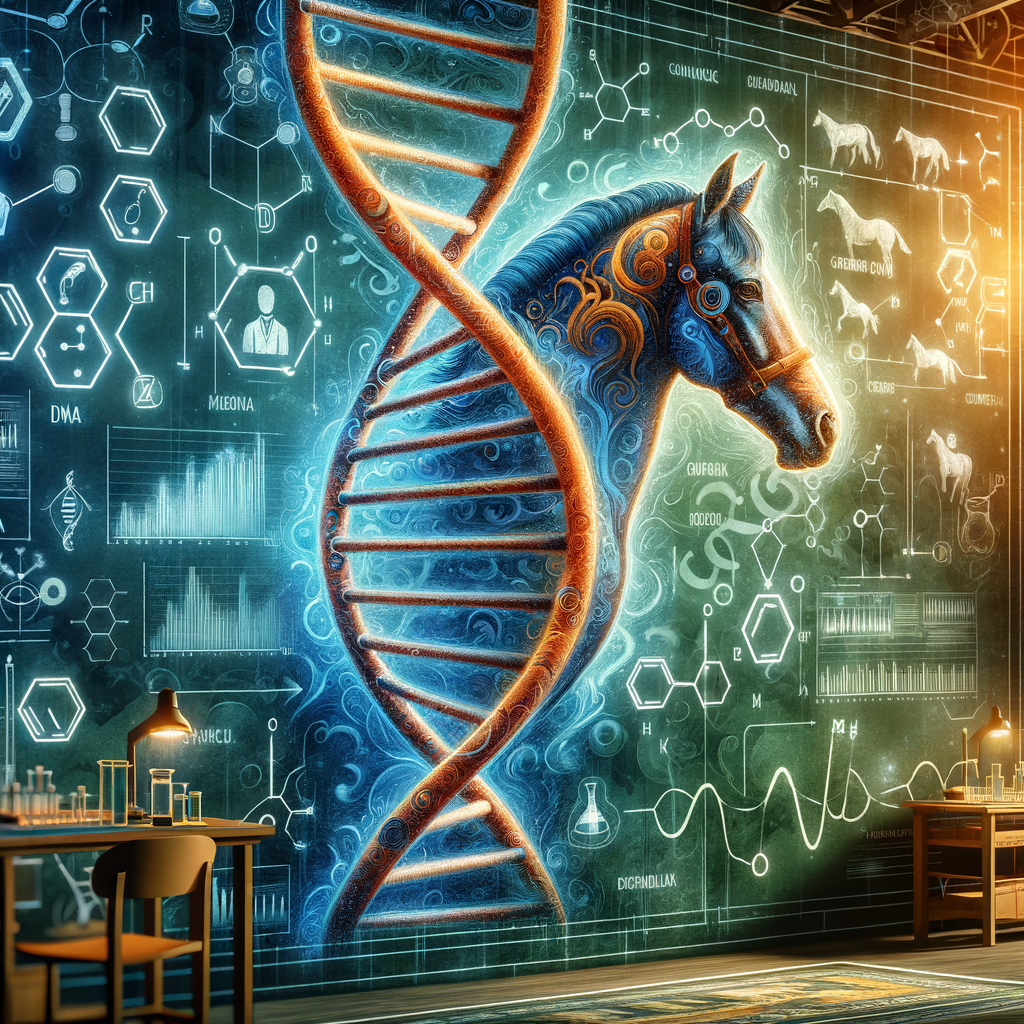
Introduction to Quarter Horse Genetics
Welcome to a fascinating journey into the world of Quarter Horse genetics. In this article, we will delve into the captivating realm of horse genetics, focusing on one of the most popular breeds in the world – the Quarter Horse. We will explore the importance of understanding genetics in relation to this breed and how it can provide valuable insights into their unique characteristics.
- Overview of the Quarter Horse breed
The Quarter Horse, named for its exceptional speed over a quarter-mile distance, is a breed that originated in the United States. Known for their muscular build, versatility, and friendly disposition, Quarter Horses are often used in rodeos, horse shows, and as working ranch horses. They are also popular as family pets due to their calm and trainable nature.
One of the unique aspects of Quarter Horses is their wide range of colors and patterns, which include sorrel, black, bay, gray, palomino, and more. This diversity in appearance is a result of the complex interplay of genes, making the Quarter Horse a fascinating subject for genetic studies.
- Importance of genetics in understanding Quarter Horses
Genetics play a crucial role in understanding the Quarter Horse breed. By studying their DNA, we can gain insights into their physical traits, health conditions, and even behavior. For instance, the genetic reason behind their impressive speed and agility lies in a specific gene that influences muscle development.
Moreover, genetics can help us understand and manage health issues that are prevalent in the breed. For example, certain genetic disorders like Polysaccharide Storage Myopathy (PSSM) and Hereditary Equine Regional Dermal Asthenia (HERDA) are more common in Quarter Horses. By identifying the genes responsible for these conditions, we can develop effective strategies for prevention and treatment.
Understanding the genetics of Quarter Horses not only enhances our knowledge about this remarkable breed but also contributes to their health, welfare, and performance. As we continue to unlock the mysteries of horse genetics, we can look forward to a future where we can further improve the lives of these magnificent creatures.
Unlocking Horse Genetics: The Basics
Before we delve into the fascinating world of horse genetics, it’s important to understand some basic concepts. Let’s start our journey by introducing equine genetics, understanding the role of DNA, and exploring the genetic traits in horses.
- Introduction to equine genetics
- Role of DNA in horse genetics
- Understanding genetic traits in horses
Equine genetics is a branch of science that studies the genes and heredity in horses. Just like humans, horses inherit their traits from their parents. This includes their color, size, and even some aspects of their behavior. By studying equine genetics, scientists can predict these traits and even prevent certain genetic diseases.
DNA, or deoxyribonucleic acid, is like a blueprint for all living things. It contains the instructions that tell a horse’s body how to grow and function. Each horse has its own unique DNA, which is a mix of DNA from its mother and father. This is why no two horses are exactly alike, even if they are from the same breed.
Genetic traits are characteristics that are passed down from parents to their offspring through genes. These traits can be physical, like the horse’s coat color and height, or behavioral, like their temperament and ability to learn. For example, the gene for chestnut color in horses is dominant, which means a horse only needs one copy of this gene from one parent to be chestnut.
Now that we’ve covered the basics, we can dive deeper into the world of horse genetics. In the following sections, we will explore the mysteries of Quarter Horse genetics, delve into their DNA, and understand the implications and applications of their genetic traits.
| Term | Definition |
|---|---|
| Equine Genetics | The study of genes and heredity in horses |
| DNA | The blueprint for all living things that contains instructions for growth and function |
| Genetic Traits | Characteristics passed down from parents to their offspring through genes |
Understanding horse genetics is not just about knowing why a horse looks a certain way. It’s also about improving the health and well-being of horses. By unlocking the secrets of horse genetics, we can ensure a bright future for these magnificent creatures.
Mysteries of Horse Genetics: The Case of Quarter Horses
When we delve into the world of horse genetics, one breed stands out in particular – the Quarter Horse. This breed has some unique genetic traits that set it apart from others.
Unique Genetic Traits of Quarter Horses
Let’s explore some of the unique genetic traits of Quarter Horses. These traits have been honed over centuries of selective breeding, resulting in a horse breed that is not only beautiful but also highly functional.
- Speed and agility
- Muscular build
- Distinctive coat colors
Quarter Horses are known for their exceptional speed and agility. They can reach speeds of up to 55 mph, making them one of the fastest horse breeds in the world. This speed is largely due to their unique muscle composition, which is a result of specific genetic traits.
Another distinctive trait of Quarter Horses is their muscular build. They have a compact body with a broad chest and powerful hindquarters. This muscular build is a result of a specific gene that is prevalent in this breed. This gene, known as the ‘Speed Gene’, is responsible for the development of fast-twitch muscle fibers, which contribute to the horse’s speed and agility.
Quarter Horses come in a variety of coat colors, including bay, black, chestnut, dun, gray, grullo, palomino, red dun, roan, and sorrel. These colors are determined by a complex interplay of genes, with some colors being more common than others. For example, the chestnut color is a result of a recessive gene, meaning that both parents must carry the gene for a foal to be chestnut.
These unique genetic traits of Quarter Horses not only make them a favorite among horse enthusiasts but also make them a fascinating subject for genetic research. By understanding these traits, we can gain a better understanding of horse genetics as a whole.
Quarter Horse Breeding and Genetics
When we talk about Quarter Horse breeding, the role of genetics is paramount. It’s like a secret code that determines the horse’s physical attributes, health, and performance abilities. Let’s delve deeper into this fascinating world of equine genetics.
- Role of Genetics in Breeding Quarter Horses
Genetics plays a significant role in breeding Quarter Horses. The genes inherited from the parents determine the horse’s traits, such as its speed, agility, muscular build, and distinctive coat colors. For instance, the Quarter Horse’s renowned speed and agility are a result of specific genes that enhance muscle strength and endurance.
Genetic testing has become a valuable tool in breeding programs. Breeders can identify the genes responsible for desirable traits and select breeding pairs accordingly. This practice helps to produce offspring with the desired characteristics, improving the breed’s overall quality.
- Common Breeding Practices
There are several common practices in Quarter Horse breeding. One of the most prevalent is selective breeding, where horses with specific desirable traits are bred together. This method aims to produce offspring that inherit these traits, enhancing the breed’s overall quality.
Another common practice is line breeding. This involves breeding horses that share a common ancestor to preserve specific traits. While this method can reinforce desirable characteristics, it also carries a risk of amplifying any genetic defects present in the shared ancestor.
In recent years, artificial insemination has become increasingly popular. This practice allows breeders to use the genetic material from top-quality horses, even if they are located far away. It also reduces the risk of injury to the horses during breeding.
It’s important to note that responsible breeding practices also involve considering the horse’s health and welfare. Breeders should always prioritize the wellbeing of their horses, ensuring they are healthy, well-cared for, and not overbred.
In conclusion, Quarter Horse breeding is a complex process that requires a deep understanding of genetics. By using responsible breeding practices and leveraging the power of genetic testing, breeders can continue to improve this magnificent breed.
Delving Deeper: Quarter Horse DNA
As we delve deeper into the world of Quarter Horse genetics, we discover the fascinating intricacies of their DNA. Let’s explore the latest advancements in genetic research and the key findings specific to Quarter Horses.
Genetic Research in Quarter Horses
Genetic research in Quarter Horses has taken significant strides in recent years. This research has not only helped us understand the unique traits of these horses but also paved the way for improving their health and performance.
- Recent advancements in horse genetic research
- Key findings specific to Quarter Horses
Over the past decade, scientists have made remarkable progress in horse genetic research. The advent of advanced DNA sequencing technologies has made it possible to map the entire genome of horses. This has opened up new avenues for understanding the genetic basis of their unique traits and health conditions.
Research has revealed some interesting findings about Quarter Horses. For instance, scientists have discovered that the ‘speed gene,’ which influences a horse’s ability to sprint, is prevalent in Quarter Horses. This could explain their exceptional speed and agility. Additionally, research has identified certain genetic markers linked to specific health conditions in Quarter Horses, which could aid in early detection and treatment.
These advancements in genetic research have significantly enhanced our understanding of Quarter Horse DNA. They have provided valuable insights into their unique traits and health conditions, paving the way for improved care and performance.
Genetic Disorders in Quarter Horses
Quarter Horses, known for their speed and agility, are not immune to genetic disorders. These disorders can affect their health and performance. Let’s delve into the common genetic disorders in Quarter Horses and the ongoing research on their prevention and treatment.
- Common Genetic Disorders in Quarter Horses
There are several genetic disorders that are common in Quarter Horses. These include:
| Disorder | Description |
|---|---|
| Polysaccharide Storage Myopathy (PSSM) | This disorder affects the horse’s muscles, causing stiffness, weakness, and potentially severe muscle damage. It is caused by a mutation in the GYS1 gene. |
| Hereditary Equine Regional Dermal Asthenia (HERDA) | HERDA is a skin disorder that causes the skin to be overly stretchy and fragile. It is caused by a mutation in the PPIB gene. |
| Hyperkalemic Periodic Paralysis (HYPP) | HYPP affects the horse’s muscles, causing episodes of muscle twitching, weakness, and even collapse. It is caused by a mutation in the SCN4A gene. |
- Research on Prevention and Treatment
Scientists and veterinarians are continuously researching ways to prevent and treat these genetic disorders. Here are some of the key findings:
- Genetic testing: Genetic testing can identify horses that carry the genes for these disorders. This can help in breeding decisions to prevent the disorders from being passed on to future generations.
- Diet and management: For disorders like PSSM and HYPP, changes in diet and management can help manage the symptoms.
- Medication: For some disorders, medication can help manage the symptoms. For example, horses with HYPP can benefit from medication that helps regulate their potassium levels.
While these treatments can help manage the symptoms, more research is needed to find a cure for these disorders. The hope is that with continued research, we can improve the health and quality of life for Quarter Horses affected by these genetic disorders.
Understanding Quarter Horse Genetics: Implications and Applications
Understanding the genetics of Quarter Horses is not just a fascinating scientific endeavor, but it also has practical implications and applications. In this section, we will explore how this knowledge can impact horse care, particularly in the areas of feeding and nutrition, and training and performance.
Implications of Genetic Knowledge in Horse Care
Genetic knowledge can significantly influence how we care for our horses. Let’s delve into the specifics.
- Impact on feeding and nutrition
- Implications for training and performance
Knowing the genetic makeup of a Quarter Horse can help us tailor their diet to their specific needs. For instance, some horses may be genetically predisposed to certain metabolic disorders, which can be managed with a carefully controlled diet. Understanding the horse’s genetics can help us make informed decisions about what to feed them, how much, and when.
Genetics can also play a role in a horse’s performance. Certain genetic markers may indicate a horse’s potential for speed, endurance, or agility. By understanding these markers, trainers can develop training programs that maximize a horse’s natural abilities and minimize the risk of injury.
For example, a study conducted on Thoroughbred racehorses found that horses with a specific gene variant were more likely to be successful in short-distance races, while those without it performed better in long-distance races. This kind of genetic knowledge can help trainers and owners make more informed decisions about a horse’s training and racing career.
While we’ve focused on Quarter Horses in this article, it’s important to note that the principles of genetic understanding can be applied to all breeds. The more we understand about horse genetics, the better we can care for these magnificent animals.
Applications in Breeding and Conservation
Understanding the genetics of Quarter Horses has significant applications in both breeding and conservation. Let’s delve into these two important areas.
- Improving Breeding Strategies
- Conservation of the Quarter Horse Breed
By understanding the genetics of Quarter Horses, breeders can make more informed decisions. For instance, they can select parent horses with desirable traits to produce offspring with the best possible characteristics. This can lead to healthier, stronger, and faster horses.
Take the example of speed. Through genetic understanding, breeders can identify the genes responsible for speed and stamina in Quarter Horses. By selecting parents with these genes, they can breed offspring more likely to excel in races.
Genetic knowledge also plays a crucial role in the conservation of the Quarter Horse breed. By understanding the unique genetic makeup of this breed, conservationists can work to preserve its genetic diversity. This helps ensure the long-term survival of the breed.
For instance, if a particular gene that is unique to Quarter Horses is identified as being under threat, conservation efforts can focus on protecting horses with this gene. This can help maintain the breed’s unique characteristics and prevent it from becoming diluted or lost over time.
| Application | Benefit |
|---|---|
| Breeding Strategies | Produces healthier, stronger, and faster horses |
| Conservation | Preserves the genetic diversity and long-term survival of the breed |
In conclusion, understanding Quarter Horse genetics is not just about satisfying our curiosity. It has real-world applications that can improve breeding strategies and aid in the conservation of this beloved breed. As we continue to unlock the mysteries of horse genetics, we can look forward to a future where our knowledge serves to benefit these magnificent creatures.
Conclusion: The Future of Equine Genetics
As we wrap up our exploration of Quarter Horse genetics, it’s exciting to look ahead at what the future may hold. The field of equine genetics is rapidly evolving, with new discoveries and advancements happening all the time. Let’s take a moment to consider the current trends in horse genetic research and the future directions for understanding Quarter Horse genetics.
- Current trends in horse genetic research
- Future directions for understanding Quarter Horse genetics
One of the most exciting trends in horse genetic research is the use of advanced DNA sequencing technologies. Scientists are now able to map out the entire genome of a horse, giving them a complete picture of its genetic makeup. This has opened up new possibilities for understanding diseases, behaviors, and physical traits in horses. For example, researchers have recently discovered genes that influence a horse’s speed and endurance, which could have significant implications for the racing industry.
Looking ahead, the future of Quarter Horse genetics is full of potential. One key area of focus will be the study of genetic diversity within the Quarter Horse breed. This could help breeders produce healthier, more robust horses. Additionally, researchers will continue to explore the genetic basis of specific traits and diseases in Quarter Horses. This knowledge could lead to improved treatments and prevention strategies, enhancing the health and well-being of these magnificent animals.
In conclusion, the future of equine genetics is bright, with many exciting developments on the horizon. As we continue to unravel the mysteries of Quarter Horse genetics, we can look forward to a deeper understanding of these incredible creatures, leading to improved care, breeding practices, and overall health. The journey of discovery is just beginning, and the possibilities are endless.









